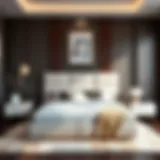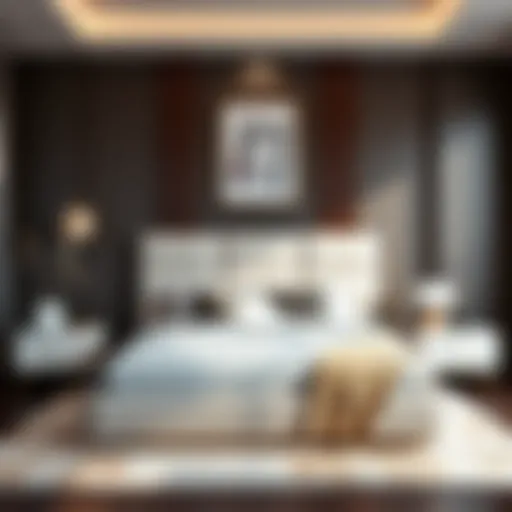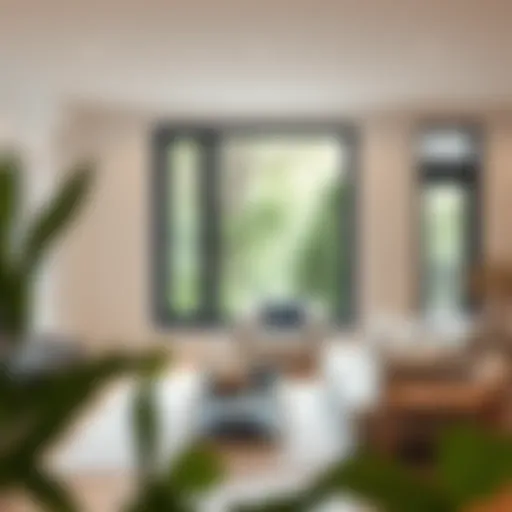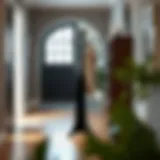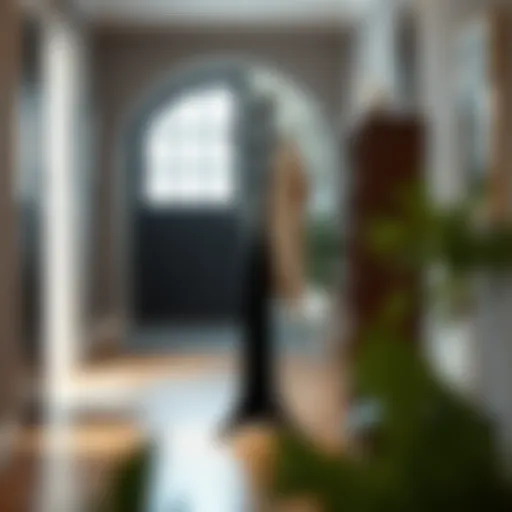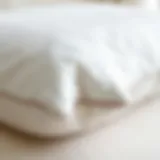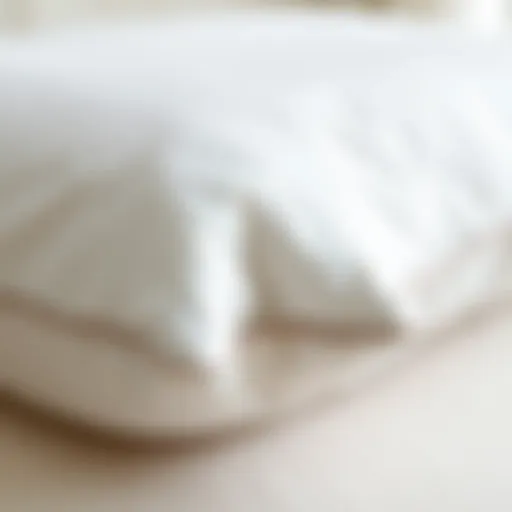Enhancing Interiors with Green and Yellow Valances
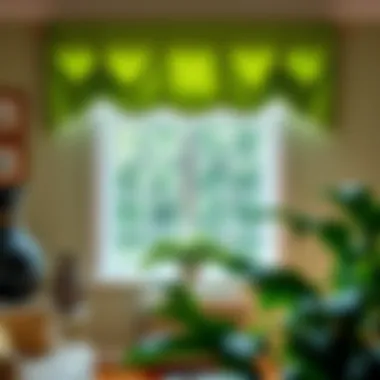
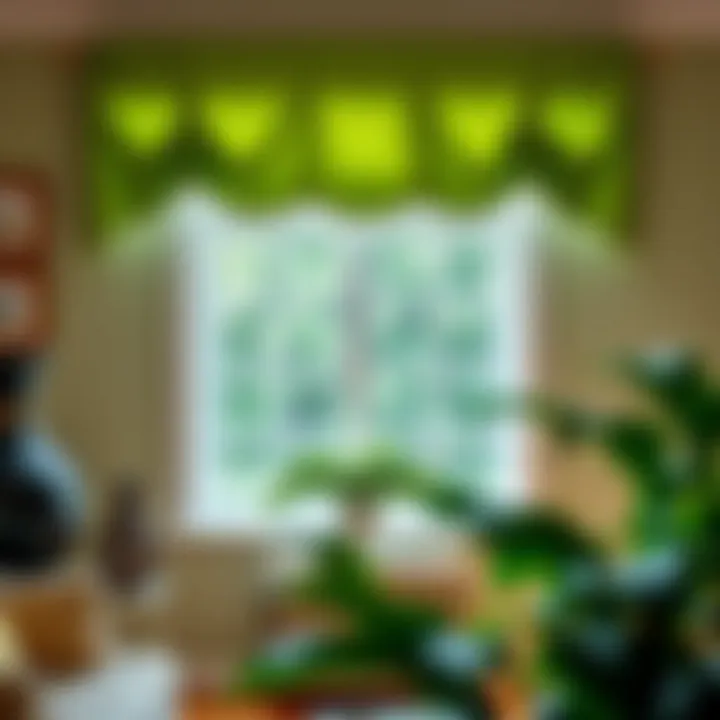
Intro
In the world of interior design, colors speak louder than words. The choice of colors not only sets the mood of a space but also plays a pivotal role in how we perceive and interact with our surroundings. Green and yellow valances, often overlooked in home decor, can bring a breath of fresh air and vibrancy to any room. These colors, symbolizing nature and warmth respectively, possess an innate ability to transform spaces into inviting and uplifting environments.
Whether you're a homeowner looking to refresh your living room or a designer seeking to add a pop of color, understanding the aesthetic and functional significance of valances becomes essential. From selecting the right materials to mastering installation techniques, this guide will walk you through every step, providing the knowledge needed to harness the full potential of green and yellow valances.
Valances don’t just serve to enhance visual appeal; they can also play practical roles such as filtering light, providing privacy, and hiding hardware. Dive in as we explore the rich landscape of textures, styles, and maintenance tips that allow these valances to shine in your home.
The Role of Valances in Interior Design
When thinking about interior design, valances may not be the first item to jump to mind, but they play a pivotal role in creating an inviting space. These fabric pieces, often hung above windows, not only control light and privacy to a degree but also serve as an integral part of the overall decor. In essence, valances act as a frame for the windows, enhancing the architectural features of a room and allowing for creative expression through color, fabric, and style.
Defining Valances
Valances are decorative pieces of fabric that are typically hung at the top of windows, just above the drapes or blinds. They come in various styles, lengths, and designs. Unlike full-length curtains, valances tend to cover only the top part of the window, creating a distinctive appearance. For instance, they might feature ruffles, pleats, or be flat. Each style can shift the vibe of a room from traditional to modern, depending on how it's executed. Valances can also be made from multiple types of fabric, offering homeowners like you an opportunity to express individuality based on preferences and themes.
Functional Benefits
Valances offer practical benefits alongside their aesthetic charm. They can help in reducing light glare by softening the incoming sunlight. Furthermore, when paired with other window treatments, valances can hide hardware like curtain rods or hooks, providing a clean and polished look. Here are a few beneficial aspects:
- Light Control: When layered with curtains or shades, valances can help manage how much light enters a room.
- Privacy: Though they don't provide complete privacy on their own, they can be a part of a layered treatment to ensure comfort without sacrificing style.
- Insulation: Valances can also contribute to energy efficiency; they act as a barrier that helps keep warmth in during colder months and block heat during hotter periods.
Aesthetic Contribution
Stylistically, valances can dramatically alter the look and feel of a space. A bright yellow valance can instantly lift the ambiance of a kitchen, adding a touch of sunshine that encourages warmth and cheerfulness. Conversely, a muted green valance might introduce a more serene feeling, perfect for a restful bedroom. These color choices allude to the psychological effects associated with different shades; green symbolizes calmness and nature, while yellow evokes happiness and brightness.
By playing with colors and fabrics, valances serve not just as window treatments but as key design elements that can tie together the various motifs of a room. They adorn the space with layers of texture, helping to create focal points that guide the eye throughout the area.
"Valances are not merely functional; they are a canvas for personal expression in design."
Understanding Color Theory in Decoration
When it comes to decorating a space, color plays a pivotal role in shaping moods, perceptions, and even functionality of areas within a home. Understanding color theory is not just a fancy notion; it’s a fundamental principle for anyone—homeowner or decorator alike—looking to create a balanced, aesthetically pleasing environment.
Color theory provides guidelines about how colors interact, evoke emotions, and influence behavior. This section right here lays out how green and yellow valances work within color theory, enhancing both visual and emotional aspects of interior design.
The Psychology of Green
Green is often associated with nature, growth, and tranquility. Psychologically, green has a soothing effect; it brings a breath of fresh air into a room. When applied through valances, shades of green can transform an interior space into a serene retreat. For instance, a soft sage valance can create a calming influence in a bedroom, promoting relaxation after a long day. Conversely, a vibrant emerald tone might invigorate a kitchen, breathing life into the space during meal preparation.
The specific shade of green can either energize or anchor the room, depending on the furniture and décor balanced with it. When you combine green with neutrals or soft pastels, it tends to create an inviting atmosphere. However, when paired with bolder colors, it can add a playful touch, which is especially useful in areas like playrooms or creative spaces.
The Impact of Yellow
Yellow, a color that embodies sunshine and positivity, is known for its stimulating and uplifting qualities. It tends to capture attention and can make spaces feel more expansive and bright. In an interior design context, yellow valances can act as a cheerful accent, injecting warmth and happiness into a room.
For example, a mustard yellow valance above a window can draw the eye and elevate the overall vibe of a space without overwhelming it. Yellow works wonders in kitchens and dining areas, engaging people and stimulating conversation. However, too much yellow might be intense; thus, moderation is key. Pairing yellow valances with gray or white can soften the brightness and maintain a sense of space and calm.
Combining Green and Yellow
The combination of green and yellow can be particularly enchanting when it comes to valances. While both colors carry their own individual benefits, together they foster a lively yet harmonious environment. This duo can transport a room into a sunny meadow, blending tranquility and cheerfulness.
When mixing these colors, one might consider the proportions involved. A soft green valance with yellow floral patterns could work well in a living room, allowing the brightness to punctuate the tranquility that green brings. In contrast, a split-tone valance—half green, half yellow—can act as a vibrant statement piece, particularly in a child’s room or a craft area.
"Color isn’t just a decor choice; it’s a language spoken in every corner of your home."
Understanding how these colors interact through the lens of color theory is vital for creating a cohesive look. Experimenting with swatches before finalizing your choice can help visualize how these hues will play together in different light scenarios throughout the day.
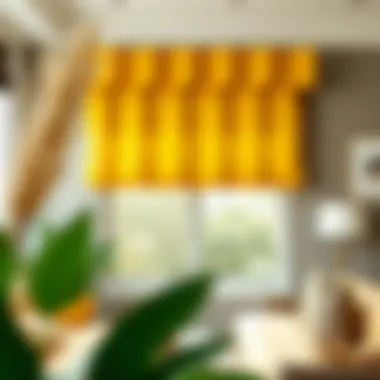
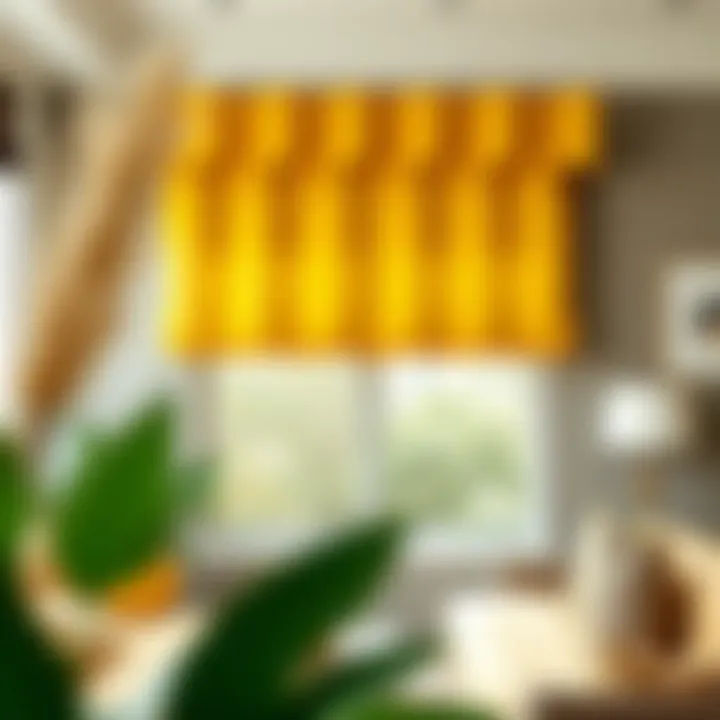
In summary, delving into color theory—specifically focusing on the psychological impacts of green and yellow—provides clarity on how these colors can not only enhance the aesthetic appeal of valances but also influence the emotional resonance of a room. Balance, moderation, and experimentation are key phrases to remember as you embark on your journey of transforming your space.
Materials and Textiles for Valances
When it comes to selecting valances for your space, the materials and textiles used can greatly influence not only the look but also the performance and longevity of these decorative elements. The right fabric can add personality and style, while poorly chosen materials might detract from your overall design. Understanding the various options available gives homeowners and designers the insight needed to make informed decisions that reflect both functionality and aesthetic appeal.
Types of Fabrics
Valances can be made from a wide range of fabrics, each bringing its own unique characteristics to the table. Here are some popular options:
- Cotton: A versatile and commonly used fabric, cotton is easy to maintain and comes in countless colors and patterns. It's breathable, making it suitable for warmer climates.
- Linen: Known for its elegance, linen offers a more textured finish. It drapes beautifully but may wrinkle easily, which can be a consideration for appearance.
- Polyester: This synthetic fabric is durable and resistant to shrinking and stretching. It can imitate natural fibers beautifully and is often more affordable.
- Silk: A luxurious option, silk valances add a touch of sophistication. However, they may require special care to maintain their appearance and are often less practical for high-traffic areas.
- Velvet: Rich and plush, velvet valances create drama and warmth in a room. They are great for colder settings, but be cautious, as they can attract dust and may require more maintenance.
Choosing the right textile isn't just about aesthetics; it influences the room's ambiance too. Fabrics with a lighter weight can create an airy feel, while heavier fabrics might contribute to a cozier atmosphere.
Eco-Friendly Options
Sustainability is becoming increasingly important in interior design. Many are looking for eco-friendly options when selecting materials for valances. Here are some sustainable choices:
- Bamboo: This fast-growing plant is not only eco-friendly but also offers a unique look that can add a natural element to your decor. Bamboo fabrics are breathable and lightweight, making them a practical choice.
- Organic Cotton: Produced without harmful chemicals, organic cotton is a more sustainable option compared to traditional cotton. It's softer and kinder to the skin, which is particularly beneficial in children's rooms or nurseries.
- Hemp: Known for its durability, hemp is a strong and environmentally-friendly choice. It requires less water and pesticides to grow compared to conventional cotton fabrics.
- Recycled Materials: Some companies have started to create fabrics from recycled plastic bottles. This innovative solution is not only good for the environment but also showcases a modern approach to design.
By opting for eco-friendly textiles, homeowners and designers show commitment to sustainability while still achieving beautiful interiors. In addition to being a responsible choice, these materials often lead to reduced maintenance costs and increased durability over time.
Investing in the right materials for your valances allows you to uplift your space, reflecting not only personal taste but also a commitment to environmental consciousness.
Choosing textiles wisely can shape the ambiance and functionality of each room in your home, marrying style with sustainability.
Styles of Green and Yellow Valances
When it comes to choosing the right valance for your space, understanding various styles of green and yellow valances can be quite enlightening. Valances, which typically appear at the upper edge of the window treatment, can profoundly influence a room's look and feel. Therefore, it's important to notice how certain styles can either enhance or detract from the overall design goals.
Styles embody more than just aesthetics; each one carries its own intricacies and potential benefits. For instance, understanding traditional designs versus modern interpretations can help homeowners and designers alike tailor their decor to either evoke nostalgia or showcase contemporary trends. Custom and DIY options also provide avenues for personalization, allowing creativity to flourish.
Here, we will delve into three key subcategories of valance styles: Traditional Designs, Modern Interpretations, and Custom and DIY Options. Each style offers unique characteristics, making them suitable for diverse spaces and preferences.
Traditional Designs
Traditional designs in valances often feature ornate details, intricate patterns, and rich fabrics, transporting us to an era where craftsmanship was held in high regard. These designs typically include classic materials such as brocade or damask and often incorporate fringe or tassels for added flair.
Such valances can evoke a sense of warmth and familiarity, helping to create a cozy atmosphere in a living room or bedroom. They're perfect for traditional or transitional styles where elegance takes center stage. Consider these elements when opting for a traditional design:
- Color Depth: Rich greens and yellows, like olive or mustard, tend to harmonize beautifully with deep woods or golden accents.
- Fringe Details: Look for valances that feature tassels or fringes. They add texture and a tip of the hat to the traditions of interior design.
The elegance of traditional designs can often be accentuated by layering with other window treatments, such as sheer curtains, enhancing light entry while maintaining privacy.
Modern Interpretations
Modern interpretations of green and yellow valances break the mold of yesterday's patterns and textures. These designs lean toward minimalism and sleek lines. Fabrics such as linen or cotton blends in solid colors or simple geometric prints are common choices.
The appeal of modern valances lies in their versatility and clean aesthetic, making them suitable for any room in a contemporary home. Employing colors like lime green paired with a crisp white or soft yellow can brighten the space and foster an airy feel. Key considerations include:
- Simplicity: Emphasizing streamlined shapes and clean finishes.
- Flexibility: These designs harmonize effortlessly with both bold and muted decor styles.
Modern valances work particularly well in kitchens and bathrooms, where fresh colors can invigorate the atmosphere and create a lively ambiance. They can also complement sleek blinds or shades, reinforcing a unified look.
Custom and DIY Options
Custom and DIY options offer an exciting opportunity for personalization, making it easy to design valances that speak to individual tastes and aesthetics. Whether you are sewing your own valance or commissioning a designer, the customization process allows for unique fabric choices and decorative elements.
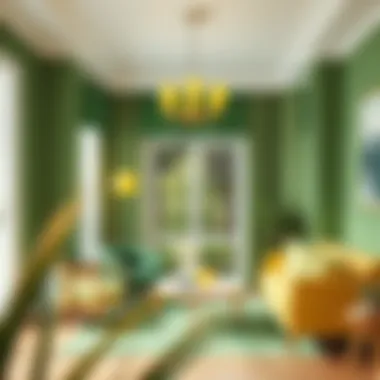
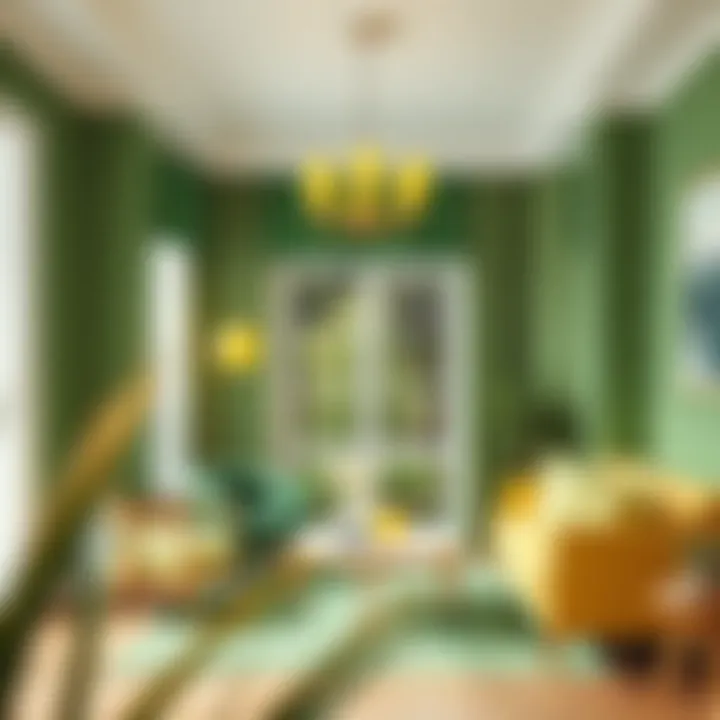
For the DIY enthusiasts, you might consider sewing a valance using old linens, thrift store finds, or even fabric remnants from other projects. This can lead to a beautiful and often meaningful addition to your window treatments. Some points to keep in mind are:
- Fabric Choice: Using green and yellow fabrics that are left over can breathe new life into them.
- Design Flexibility: Experiment with ruffles, pleats, or other details to add a unique twist.
If sewing isn't in your skill set, you can explore online platforms to find services that offer tailor-made options based on your measurements and preferred style. Crafting a valance can transform not just your windows but also frame your landscape preferences while reflecting your distinctive taste.
In summary, understanding the various styles of green and yellow valances allows you to choose designs that resonate with your desired setting, personality, and overall aesthetic vision. Valances are more than mere window adornments—they're a canvas for showcasing style and individuality.
Installation Techniques
Understanding the right installation techniques for valances is crucial for achieving the desired aesthetic and functional effects in your space. Proper installation not only enhances the visual appeal but also ensures durability and usability. A well-installed valance can set the tone of a room, framing windows and contributing to the overall décor seamlessly. This section will cover essential tools required for the installation and a step-by-step guide to simplify the process for homeowners, renters, and DIY enthusiasts.
Tools Needed for Installation
Before you take the plunge into installing your green or yellow valances, it’s important to gather the right tools to make your task smooth and efficient. Here’s a list of essential tools you might need:
- Measuring Tape: Accurate measurements lead to a fitting look. Don’t skimp on this.
- Level: Ensures that your valance hangs straight and looks professional.
- Screwdriver (or drill): Useful for mounting brackets and fastening.
- Ladder: Depending on the height of your windows, a stable ladder might be necessary.
- Pencil: For marking measurements without leaving permanent marks.
- Hammer: Sometimes needed for nails, particularly if not using screws.
- Iron (if applicable): To remove any creases from your valance fabric.
Having these tools ready will save you from the hassle during installation, allowing for a smoother process.
Step-by-Step Installation Process
Installing valances may seem daunting, but with the right approach, it can be straightforward. Here’s a detailed guide to help you through each step:
- Choose the Location: Decide how high above your window you want the valance to sit. A good rule of thumb is to position it about 4-6 inches above the window frame to create an illusion of height.
- Measure and Mark: Use your measuring tape to find the exact spot for the installation. Mark the positions for your brackets lightly with a pencil.
- Install the Brackets: Attach the brackets at the marks you made. Use a level to ensure they’re straight before securing them with screws. If needed, use a drill for added precision.
- Prepare Your Valance: If your valance needs ironing, take a moment to smooth it out. Wrinkles can detract from the overall appearance.
- Hang the Valance: Once the brackets are installed, simply hang the valance. Depending on the design, you may either slide it onto a rod or attach it directly to the brackets.
- Final Adjustments: Step back and take a look. Adjust the valance as needed to ensure it hangs evenly and looks appealing.
A well-planned installation can make all the difference. Valances that are hung with care not only enhance the look of a room but also last longer and perform better.
Using the right tools and following a structured process can transform the potentially laborious task of valance installation into an empowering and rewarding project. Whether you're upgrading your living room, enhancing your bedroom, or adding flare to a kitchen, taking your time with installation will yield results you can be proud of.
Valance Maintenance
Keeping your valances in tip-top shape goes well beyond just aesthetics; it’s about ensuring longevity and maintaining the charm they bring to any room. Valances can be subjected to a fair share of dirt, dust, and daily wear. Proper maintenance not only keeps them looking fresh but also enhances the overall appeal of your space. So, let�’s dive into the two crucial aspects of valance maintenance: cleaning techniques and dealing with sun fading.
Cleaning Techniques
Routine cleaning is essential to preserving the beauty of your valances. Here’s a straightforward approach to keep them shining:
- Dusting Regularly: Use a microfiber cloth or a duster to gently remove dust from the valance fabric. This should be done at least once a week, especially in homes with pets or high foot traffic.
- Spot Cleaning: For minor stains, a simple solution of mild soap and water applied with a clean cloth often does the trick. Blot rather than rub to prevent damage.
- Machine Washing: Check the care label first. If machine washing is possible, use cold water and a gentle cycle. Avoid fabric softeners that might leave residues. Always hang to dry instead of using the dryer to maintain shape and color.
- Professional Cleaning: For more intricate or delicate materials, consulting a professional cleaner can be a wise decision.
"A little care goes a long way, ensuring your valances retain their full dazzle for years to come."
Dealing with Sun Fading
Sunlight can be a double-edged sword in the world of interior design. It brings warmth and light but also has the knack for turning vibrant colors into dull shades over time. Here’s how to effectively combat sun fading on your valances:
- Use UV-Resistant Fabrics: When selecting new valances, opt for fabrics specifically designed to resist fading. Sunbrella or other outdoor fabrics are often robust against UV rays.
- Curtains as Shields: Hang additional sheer curtains or blinds behind your valances. This adds an extra layer against harsh sunlight.
- Rotate Installations: If possible, switching valances seasonally can help distribute sun exposure and minimize fading across different periods.
- Tinted Windows: Investing in window treatments that block UV rays can save your valances, not to mention protect your furnishings from fading too.
These maintenance tips ensure that your green and yellow valances continue to add vibrancy to your spaces while standing the test of time. Remember, a little effort in maintenance today reaps rewards in longevity and visual impact tomorrow.
Incorporating Valances into Different Rooms
In the realm of interior design, the installation of valances is not merely a decorative decision but one that impacts the overall ambiance of a space. Valances serve as a bridge connecting different design elements, enhancing not only the aesthetic appeal but also the functionality of a room. When integrating green and yellow valances into various rooms, it is critical to consider the room's purpose, the color palette, and the existing décor style. Valances can bring warmth, create a sense of cohesion, or even make a dramatic statement depending on their application.
Living Rooms
Living rooms are often the heart of a home, a gathering place for family and friends. This makes it essential for them to feel welcoming and stylish. Green and yellow valances can play a pivotal role in achieving this ambiance.
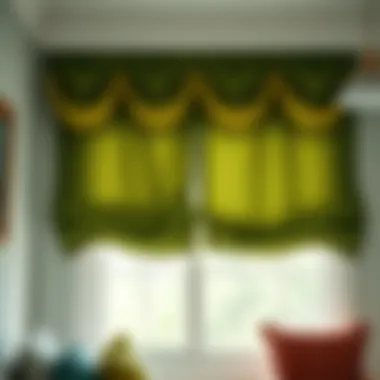
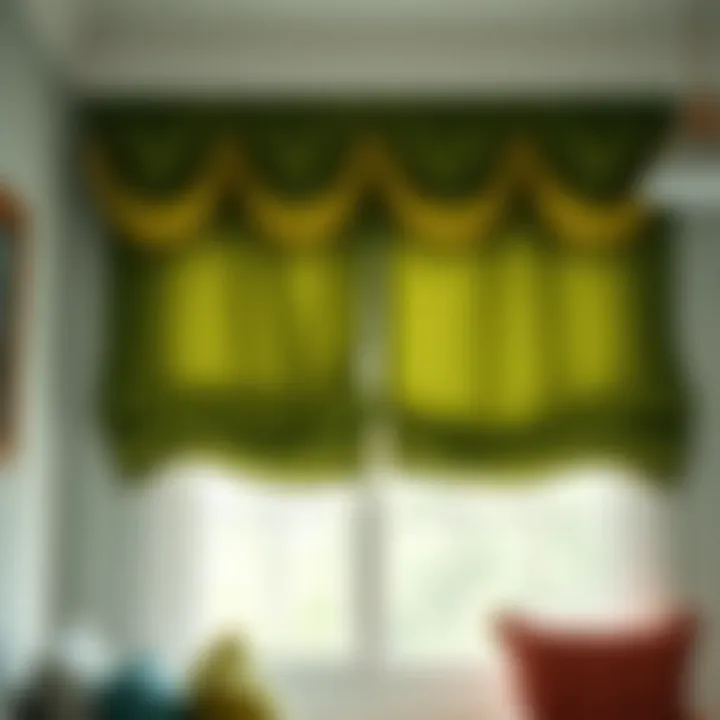
- Connection to Nature: Green, reminiscent of the outdoors, brings a fresh vibe, while yellow exudes warmth and cheer. Together, they can create a calming yet vibrant atmosphere.
- Complementing Furniture: If your living room features wooden furniture or natural fibers, green valances can highlight these elements, giving the room a grounded look. On the other hand, yellow valances can serve to brighten up darker furniture or accentuate brighter color schemes.
- Pacing and Balance: When done right, these colors can guide the eye around the room. Consider using a patterned valance that combines both hues to tie everything together seamlessly.
Kitchens
Kitchens often reflect personal taste and the energy of the household. The choice to use green and yellow valances in this space can infuse it with life and energy.
- Cheerful Ambiance: Yellow is known to stimulate appetite, making it an ideal choice for kitchens. This can be balanced effectively with softer greens that evoke freshness, especially in spaces where herbs or plants are part of the décor.
- Functional Design: In a kitchen where sunlight plays a big role, valances can frame windows beautifully while controlling how light enters the room. This can enhance the cooking experience by ensuring a balance of light and airy space.
- Material Matters: Choosing fabrics that can withstand kitchen conditions—such as cottons or blends that are both durable and easy to clean—ensures that your valances will look fresh even after multiple washes.
Bedrooms
Bedrooms are personal sanctuaries, where comfort and style converge. Incorporating valances in shades of green and yellow can contribute significantly to a restful and soothing environment.
- Restful Retreat: Soft green tones can create a serene backdrop, promoting relaxation. Yellow can be used to introduce cheerfulness—perhaps in a bright accent pattern that encourages positive energy.
- Layering Textiles: The layering of textures from valances, alongside curtains or drapes, can add depth and coziness. This thoughtful design invites comfort, perfect for unwinding at the end of the day.
- Seasonal Changes: With valances, it becomes easy to refresh your room without much hassle. A simple switch from subdued greens to brighter yellows can reflect the changing seasons, keeping the space feeling alive and in tune with nature.
In summary, incorporating green and yellow valances into various rooms can be an artful endeavor that enhances not just aesthetics but also functionality. Homeowners and decorators alike should consider these colors carefully in accordance with each room's purpose and existing color schemes for optimal results.
Valances and Sustainability
As more people embrace eco-conscious living, sustainable practices have seeped into every corner of design, including the use of valances. Homeowners and decorators alike now realize that a well-placed valance doesn’t just flatter a window; it should also align with sustainable principles. Green and yellow valances offer an opportunity to incorporate nature-inspired colors while making responsible choices about materials and production. These eco-friendly options shine a light on how style and sustainability can go hand in hand, making every home not just visually appealing but also socially responsible.
Sustainable Sourcing Practices
In the world of interior design, sustainable sourcing refers to acquiring materials that are environmentally friendly and ethically produced. When looking for green and yellow valances, several sourcing practices can be considered:
- Organic Fabrics: Textiles made from organic cotton or linen are grown without harmful pesticides or chemicals. This is not only safer for the environment but also for those living in the home.
- Recycled Materials: Some valances are crafted from recycled fabrics. By giving old materials a second life, you reduce waste and conserve resources. Plus, recycled fabrics can carry unique textures and vibrant colors.
- Locally Sourced: Supporting local artisans can minimize your carbon footprint. When you buy locally made valances, it eliminates the need for long-distance shipping, thereby cutting down transportation emissions.
- Ethical Brands: Look for brands that are transparent about their sourcing practices. They should outline how their products are made and where the materials come from. This sort of transparency builds trust and promotes responsible consumerism.
Incorporating these sustainable practices when choosing valances is a step towards creating a more eco-friendly home environment.
Long-Term Value of Eco-Friendly Choices
Investing in eco-friendly valances not only enhances the visual appeal of a space but also adds long-term value to your home in several ways:
- Durability: Many sustainable fabrics are designed to withstand years of use. High-quality organic materials can resist fading and wear better than their conventional counterparts, meaning you won’t have to replace them as often.
- Reduced Energy Costs: Valances help to better insulate windows, which can contribute to lower heating and cooling bills. Eco-friendly fabrics may also have better insulating properties that can further enhance this benefit.
- Healthier Environment: Using non-toxic, sustainably sourced materials leads to better indoor air quality. You won’t have to worry about off-gassing from harmful chemicals that are often present in conventional textiles.
- Increased Home Value: As sustainability becomes more important to buyers, having eco-friendly features like sustainable valances can give your home a competitive edge in the market. Buyers are often willing to pay a premium for homes that reflect their values, including a commitment to environmental stewardship.
Choosing green and yellow valances with sustainability in mind goes beyond aesthetics. It’s about fostering a lifestyle that prioritizes the environment while providing functional and aesthetic benefits.
The End
As we wrap up our exploration of green and yellow valances, it’s essential to highlight the unique role they play in interior design. Valances are not just trimming; they add personality to a room, transforming bare window spaces into statement pieces. The right valance can serve as the icing on the cake, combining form and function seamlessly.
When considering home decor, many homeowners and designers might overlook valances, yet they are the unsung heroes of window finishing. Balancing aesthetics with practicality, these fabric adornments can enhance natural light while providing a splash of color that resonates with the rest of the decor.
Benefits of Choosing Green and Yellow Valances:
- They bring warmth and life into various spaces.
- Green hues promote calmness, making them ideal for living areas and bedrooms.
- Yellow can spark creativity, perfect for kitchens and workspaces.
In choosing your valances, various considerations come into play: the style of the room, the amount of light you wish to filter, and the overall ambiance you hope to create. The combination of green and yellow not only follows color psychology principles but also aligns with current trends that favor lively, energetic environments.
As we venture further into home improvement, understanding the significance of valances, particularly in warm colors, will certainly enrich your design decisions. It’s about finding that perfect balance, and remember, every detail counts.
Recap of Key Points
In this article, we delved into various aspects concerning green and yellow valances, emphasizing how they contribute to both the look and functionality of a space. Here’s a quick recap of what we covered:
- The Role of Valances: We defined what valances are and laid out their various benefits and aesthetic contributions.
- Color Theory: We discussed how green and yellow affect moods and how they can complement each other.
- Materials: There’s a multitude of fabrics available, with a growing trend towards eco-friendly options, showcasing a commitment to sustainability.
- Styles: Whether it be traditional, modern, or custom designs, there’s a valance style to fit any decor.
- Installation and Maintenance: We provided practical insights into installation techniques and maintenance tips to keep your valances looking their best.
- Sustainability: The importance of choosing sustainable sources for your valances was stressed, highlighting long-term value.
Future Trends in Valance Design
Looking toward the future, valances are set to become even more versatile and functionally integrated into our living spaces. Here are some emerging trends to keep an eye on:
- Smart Textiles: Innovations in fabric technology may yield materials that respond to light or temperature, enhancing comfort and energy efficiency.
- Layering Techniques: Designers may explore layering valances with other window treatments, such as sheer drapes, for more depth and texture.
- Minimalist Designs: A shift towards simpler, more understated valance designs can help in achieving a cleaner look that doesn’t overwhelm the space.
- Customization: Homeowners are increasingly looking for personalized options. Whether it’s design, fabric, or color, customized valances will prevail.
- Sustainable Practices: As environmental awareness continues to grow, sustainable materials and practices in valance production are likely to take the forefront.
The landscape of interior design is ever-evolving, and valances are stepping into the limelight with renewed relevance. Keeping an eye on these trends can help you select options that not only look great but also reflect a conscious choice in modern decor.
